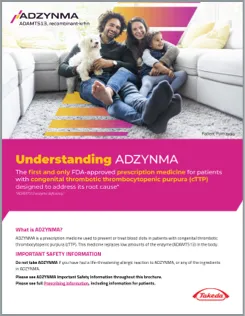Courtney: Hi, my name is Courtney. I’m going to show you how to reconstitute ADZYNMA and administer it to your patients.
Courtney: As ADZYNMA is administered by intravenous injection, it’s important to use aseptic technique (clean and germ free) throughout the procedure.
Courtney: Before we start, we need to wash and dry our hands thoroughly and put on clean exam gloves.
Courtney: First, let’s prepare a clean, germ-free, flat surface and gather all the materials needed for reconstitution and administration.
Courtney: Materials for reconstitution.
- Baxject II HI-Flow device
- Diluent vial
- Vial of ADZYNMA powder
Courtney: Materials for administration.
- Alcohol swabs
- Luer-lock syringe
- Infusion set
Courtney: Check the expiration date on the vial or carton of ADZYNMA and do not use if the expiration date has passed or if not stored properly.
Courtney: Allow the vials to reach room temperature before use.
Courtney: Now we’re ready to prepare ADZYNMA for injection. Remove the plastic caps from the ADZYNMA and diluent vials and place them on a flat surface.
Courtney: Wipe the rubber stoppers on the top of the vials with an alcohol swab and let them dry.
Courtney: Next, open the BAXJECT II Hi-Flow device by peeling away the lid, being careful not to touch the inside of the pack.
Courtney: Turn the package with the BAXJECT II Hi-Flow device upside down and place it over the top of the diluent vial.
Courtney: Press it straight down until the clear plastic spike pierces the stopper of the diluent vial.
Courtney: Grip the BAXJECT II Hi-Flow device package at its edge and pull the package off the device.
Courtney: For the next step, we need to turn the system over so that the diluent vial is on top. Press the BAXJECT II Hi-Flow device straight down until the purple plastic spike pierces the ADZYNMA powder vial stopper.
Courtney: The vacuum will draw the diluent into the vial containing ADZYNMA powder. You may notice some bubbles or foam; this is normal and should soon disappear. Wait until bubbles or foam dissipate before administration.
Courtney: Now swirl the connected vials gently and continuously until the ADZYNMA powder is completely dissolved. It is important not to shake the vial.
Courtney: Before administering ADZYNMA, inspect the reconstituted solution visually for any particulate matter or discoloration. The solution should be clear and colorless.
Courtney: Do not use the solution if you see any particulate matter or discoloration.
Courtney: Once reconstituted, you should use ADZYNMA within 3 hours and keep at room temperature. Do not store at any other temperature. Discard any unused product if not used within 3 hours after reconstitution.
Courtney: We are now ready to administer ADZYNMA. Let’s go through these steps together.
Courtney: Take off the blue cap from the BAXJECT II Hi-Flow device and attach a Luer-lock syringe, without injecting air into the system. Turn the system upside down so the solution for infusion is at the top (ADZYNMA vial is now on top).
Courtney: Draw the solution into the syringe by pulling the plunger back slowly.
Courtney: If the dose you need for your patient requires more than one vial of ADZYNMA, you will need to reconstitute each vial according to the instructions provided earlier in this video.
Courtney: You will need to use a different BAXJECT II Hi-Flow device to reconstitute each vial.
Courtney: Additional vials of reconstituted product can be drawn into the same syringe to avoid administering multiple injections. Reconstitute each vial using a new BAXJECT II Hi-Flow device each time, and draw the product into the syringe until the total volume to be administered is reached.
Courtney: Disconnect the syringe and attach a suitable injection needle or infusion set. To remove any air bubbles, point the needle upwards and gently tap the syringe with your finger.
Courtney: Slowly and carefully push the air out of the syringe and needle.
Courtney: Now we are ready to administer ADZYNMA.
Courtney: First, apply a tourniquet to your patient’s arm and clean the chosen infusion site with an alcohol swab.
Courtney: Insert the needle into your patient’s vein and remove the tourniquet. ADZYNMA should be infused slowly, at a rate of 2 to 4 milliliters per minute. You may want to use a syringe pump to control the rate of infusion.
Courtney: Once administration is complete, remove the needle from the vein and put pressure on the infusion site with a cotton ball or gauze for several minutes to stop bleeding.
Courtney: Do not recap the needle. Place the needle, syringe, and vials in a puncture-resistant sharps container.
Courtney: Vials are for single use only and any remaining solution must be discarded in accordance with local requirements.
Courtney: That completes the reconstitution and administration of ADZYNMA.
Courtney: I hope this has been helpful. Thank you for joining me today.
Courtney:
ADZYNMA (ADAMTS13, recombinant-krhn) INDICATION & IMPORTANT SAFETY INFORMATION
INDICATION
ADZYNMA (ADAMTS13, recombinant-krhn) is a human recombinant “A disintegrin and metalloproteinase with thrombospondin motifs 13” ADAMTS13 (recombinant ADAMTS13) indicated for prophylactic or on-demand enzyme replacement therapy (ERT) in adult and pediatric patients with congenital thrombotic thrombocytopenic purpura (cTTP).
IMPORTANT SAFETY INFORMATION
ADZYNMA is contraindicated in patients who have experienced life-threatening hypersensitivity reactions to ADZYNMA or its components.
Hypersensitivity Reactions: Allergic-type hypersensitivity, including anaphylactic reactions, may occur with ADZYNMA. Patients should be educated about early signs of hypersensitivity such as tachycardia, chest tightness, wheezing and/or acute respiratory distress, hypotension, generalized urticaria, pruritus, rhinoconjunctivitis, angioedema, lethargy, nausea, vomiting, paresthesia, and restlessness. If signs and symptoms of severe allergic reactions occur, immediately discontinue administration of ADZYNMA and provide appropriate supportive care.
Immunogenicity: There is a potential for immunogenicity with ADZYNMA. Patients may develop neutralizing antibodies to ADAMTS13, which could potentially result in a decreased or lack of response to ADAMTS13. Patients may develop antibodies to host cell proteins which could potentially result in adverse reactions. There are no data on immunogenicity with ADZYNMA or to host cell proteins in previously untreated patients (subjects naïve to plasma-based products).
Adverse Reactions: The most commonly observed adverse reactions (>5% of subjects) associated with ADZYNMA are headache, diarrhea, migraine, abdominal pain, nausea, upper respiratory tract infection, dizziness and vomiting.
Use in Specific Populations: The safety of ADZYNMA for use during pregnancy has not been established in controlled clinical trials. Limited data are insufficient to inform a drug associated risk of adverse developmental outcomes. There is no information regarding the presence of ADZYNMA in human milk, its effects on milk production, or the breastfed infant.
To report SUSPECTED ADVERSE REACTIONS, contact Takeda Pharmaceuticals U.S.A., Inc. at 1-877-TAKEDA-7 (1-877-825-3327) or FDA at 1-800-FDA-1088 or www.fda.gov/medwatch.
Please see full Prescribing Information, including information for patients.






